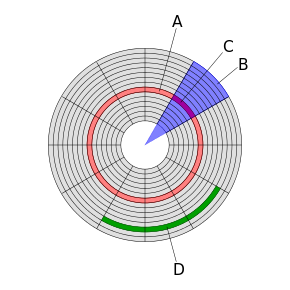In computer disk storage, a sector also known as a page is a subdivision of a track on a magnetic disk or optical disc. Each sector stores a fixed amount of user-accessible data, traditionally 512 bytes for hard disk drives (HDDs) and 2048 bytes for CD-ROMs and DVD-ROMs. Newer HDDs use 4096-byte (4 KiB) sectors, which are known as the Advanced Format (AF).
Geometrically, the word sector means a portion of a disk between a center, two radii and a corresponding arc (see Figure 1, item B), which is shaped like a slice of a pie. Thus, the disk sector (Figure 1, item C) refers to the intersection of a track and geometrical sector.
In disk drives, each physical sector is made up of three basic parts, the sector header, the data area and the error-correcting code (ECC). The sector header contains information used by the drive and controller; this information includes sync bytes, address identification, flaw flag and header parity bytes. The header may also include an alternate address to be used if the data area is undependable. The address identification is used to ensure that the mechanics of the drive have positioned the read/write head over the correct location. The data area contains the recorded user data, while the ECC field contains codes based on the data field, which are used to check and possibly correct errors that may have been introduced into the data.
History
Early in the computing industry, the term block was loosely used to refer to a small chunk of data. Later the term referring to the data area was replaced by sector, and block became associated with the data packets that are passed in various sizes by different types of data streams. For example, the Unix program

